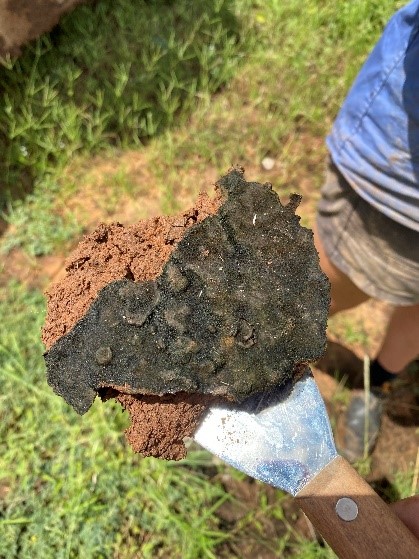Biocrusts – ‘The living skin of rangeland soils’
What are biocrusts?
Biological soil crusts, commonly known as ‘biocrusts’, are found on the soil surface in arid, semi-arid and tropical seasonally arid ecosystems. In the dry season, biocrusts dry out and partially decompose. They become active again with the onset of the wet season, regrowing and often presenting as a slimy coating.
Biocrust consists of a diverse community of microorganisms, including:
- Algae
- Mosses
- Lichens
- Liverworts
- Cyanobacteria

What functions and benefits do biocrusts have?
- Biocrusts stabilise the soil surface – they intertwine with soil particles to bind them together, preventing erosion from wind and water.
- They photosynthesize and fix carbon – algae, cyanobacteria, lichens, liverworts and mosses are all green and photosynthesize just like plants. The carbon they pull out of the air is incorporated into the soil and enhances soil carbon.
- They fix nitrogen – most cyanobacteria fix nitrogen out of the air just like legumes do.
Biocrust in Northern Territory Rangelands research
As part of the Rain Ready Rangelands (RRR) project, funded by the Future Drought Fund, biocrust health and functionality are being measured along with vegetation and ground cover. This is because biocrusts are a sign of a healthy rangeland ecosystem and provide the added benefit of enhanced soil moisture and erosion resistance.
Understanding how biocrust composition and cover responds to grazing management across vast rangeland landscapes provides an indicator of how management can promote drought resilient soils. The RRR project is measuring biocrust response to grazing intensity and management through sampling biocrusts:
- with distance from stock waterpoints (closer is more intense grazing impacts)
- inside and outside of exclosures (with and without grazing)
- with continuous grazing vs. grazing with wet season spelling
- in paddocks with current vs. recommended grazing management.
These samples will be analysed for biocrust species composition, ground cover and DNA analysis to detect biocrusts’ functional contribution to soil stability and fertility, such as detecting nitrogen fixation genes.
We are training our demonstration collaborator producers to recognise biocrusts and their function in healthy drought resilient landscapes and how to manage grazing to promote healthy soils and biocrust. The Mount Denison RRR demonstration site and producers star in a video that educates rangeland managers about biocrusts and their pivotal role in healthy grazed landscapes.
The RRR team have collaborated with the University of Queensland and Meat and Livestock Australia to produce educational videos about the role of biocrusts in grazed rangelands landscape stability.